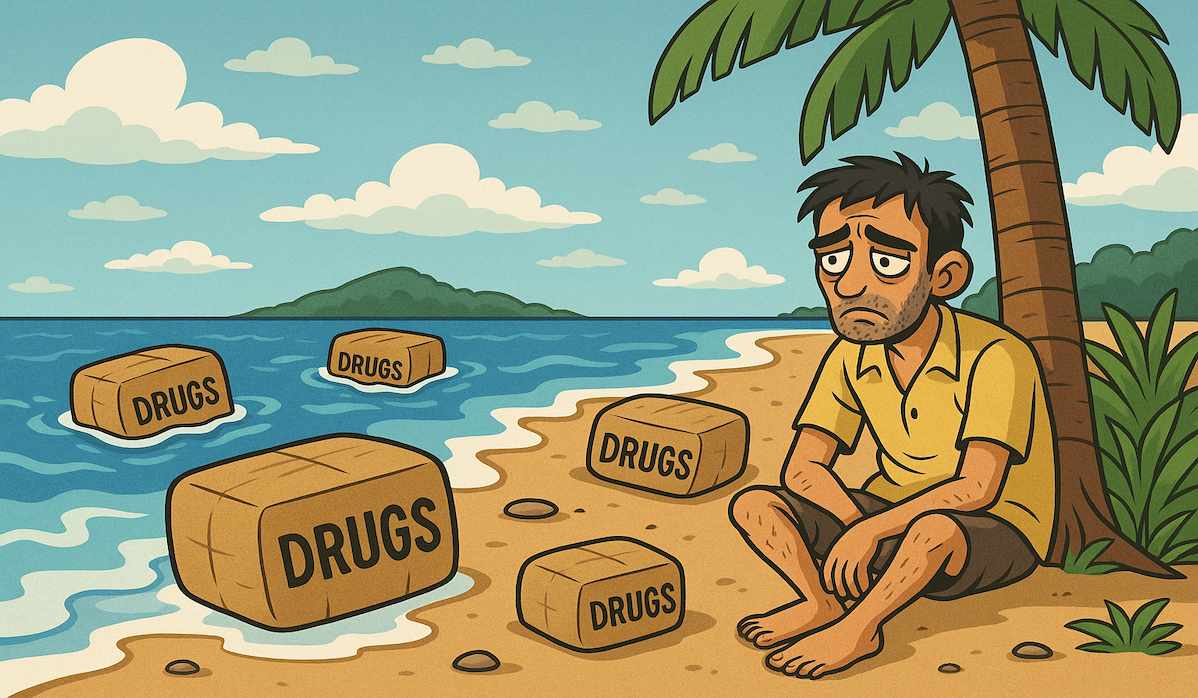Tarun Karthick
Sri Vijaya Puram, 06 May 2025
The serene shores and lush forests of the Andaman and Nicobar Islands are increasingly being tainted by a sinister force — highly addictive and dangerous drugs washing ashore in mysterious patterns, threatening the very fabric of island life. The latest and most disturbing example came on 4 May 2025, when a joint team from Police Station Billiground and Police Station Rangat recovered 20.935 kilograms of unclaimed methamphetamine from deep within the forests at Cutbert Bay, North and Middle Andaman District.
This massive drug haul discovered hidden in a remote jungle area, is not only a law enforcement milestone but also a stark reminder that Islanders are becoming unintended victims of an escalating narcotics crisis, the roots of which appear far deeper than previously imagined.
Sources in the police department confirmed that the search operation was triggered following a recent seizure of commercial quantity methamphetamine from a local resident of Cutbert Bay. This prompted authorities to comb the forests for additional stashes — a decision that bore fruit when nearly 21 kilograms of methamphetamine was discovered hidden in the dense undergrowth.
As per the FIR, no individual was found near the site at the time of the recovery, and the owner of the consignment remains unidentified. While this seizure has prevented a massive amount of psychotropic substance from hitting the streets, it simultaneously raises serious questions about the depth and scale of the drug crisis engulfing the Islands.
The successful operation is undoubtedly a credit to the dedication and vigilance of the police, who have once again ensured that a large quantity of a deadly substance will not reach vulnerable hands. The officers involved, including the extended support team, deserve formal commendation for their effort.
However, this milestone also casts a long shadow — one that brings into focus the disturbing regularity with which drugs are being discovered across different parts of the archipelago.
Is this just another isolated case? Far from it. Drug recoveries have become disturbingly frequent in recent years — and the substances being found are not limited to methamphetamine.
In March 2025, a packet of methamphetamine was found along the 22-kilometre coast of Great Nicobar Island. In May 2024, authorities at Campbell Bay Police Station seized 16 kilograms of heroin. In December 2024, 1.263 kilograms of Cocaine were recovered near the Mus Lighthouse in Car Nicobar Islands, and back in October 2023, 1.1 kilograms of Cocaine was found on the secluded shores of Tillangchong Island.
The question is no longer whether drugs are washing ashore — it is why, how, and from where.
The initial explanation that drugs washing ashore were remnants of consignments jettisoned by a Myanmarese vessel intercepted by the Indian Coast Guard in 2019 may have made sense at the time. However, given the frequency and diversity of narcotics now being discovered, that theory seems inadequate.
Are these continued finds part of spillover from smuggling routes? Are active smuggling operations frequently taking place in the seas around the Islands?
Or is there a more deliberate, dangerous motive at play — a covert plan to flood the Islands with addictive substances, hook the local population, and undermine the region from within?
One thing is clear — Islanders are paying the price. Drugs worth crores of rupees are appearing on the shores of small, peaceful communities. What may seem like random discoveries are, in effect, toxic traps that lure the vulnerable into a vicious cycle of addiction, crime, and despair.
The effects of methamphetamine, in particular, are devastating. Also known as “meth” or “ice,” it is a highly addictive stimulant that causes intense euphoria, increased activity, and aggressive behaviour. With repeated use, it ravages the brain, leading to paranoia, hallucinations, and irreversible mental damage. Physical side effects include severe weight loss, dental decay, skin sores, and heart failure.
Even a single use can lead to dependency. The downward spiral often ends in incarceration, overdose, or death.
While the efforts of law enforcement deserve applause, policing alone will not solve this crisis. There is a critical need for rehabilitation support, public education, and community intervention.
Addicts must be encouraged to come forward and seek help — not shamed, but guided toward recovery. It is only through sustained medical, psychological, and social efforts that the cycle can be broken.
At the same time, the central question remains: Why do these drugs keep appearing? Is it mere chance? Or are we looking at an orchestrated push to destabilise the region, one that intelligence and security agencies are surely aware of and actively investigating?
The discovery of 20.935 kilograms of methamphetamine in Cutbert Bay is not just a police report — it’s a distress signal. It reflects a systemic issue that cannot be ignored or brushed aside.
Islanders are increasingly becoming victims, not just of addiction but of a silent war being fought on their beaches, in their forests, and through their communities. Whether it’s methamphetamine, heroin, or cocaine — these aren’t just drugs. They’re weapons.
The fight against narcotics in the Andaman and Nicobar Islands must now go beyond arrests and seizures. It must involve a comprehensive, multi-agency response, public awareness, and most importantly, a commitment to protect our Islands and its people from this creeping menace.

